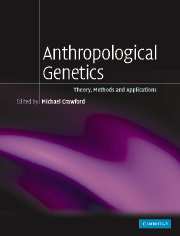Book contents
- Frontmatter
- Contents
- List of Contributors
- Preface
- Chapter 1 Foundations of Anthropological Genetics
- Part 1 Theory
- Part 2 Methods
- Chapter 4 The Importance of Field Research in Anthropological Genetics: Methods, Experiences and Results
- Chapter 5 The Confluence of Anthropological Genetics and Anthropological Demography
- Chapter 6 Molecular Markers in Anthropological Genetic Studies
- Chapter 7 The Use of Quantitative Traits in Anthropological Genetic Studies of Population Structure and History
- Chapter 8 Ancient DNA and its Application to the Reconstruction of Human Evolution and History
- Part 3 General Applications
- Part 4 Part IV The Human Diaspora
- Index
- References
Chapter 7 - The Use of Quantitative Traits in Anthropological Genetic Studies of Population Structure and History
Published online by Cambridge University Press: 05 June 2012
- Frontmatter
- Contents
- List of Contributors
- Preface
- Chapter 1 Foundations of Anthropological Genetics
- Part 1 Theory
- Part 2 Methods
- Chapter 4 The Importance of Field Research in Anthropological Genetics: Methods, Experiences and Results
- Chapter 5 The Confluence of Anthropological Genetics and Anthropological Demography
- Chapter 6 Molecular Markers in Anthropological Genetic Studies
- Chapter 7 The Use of Quantitative Traits in Anthropological Genetic Studies of Population Structure and History
- Chapter 8 Ancient DNA and its Application to the Reconstruction of Human Evolution and History
- Part 3 General Applications
- Part 4 Part IV The Human Diaspora
- Index
- References
Summary
Introduction
This chapter may seem to some to be a fond remembrance of things past. Given the increasing wealth of new data on genetic variation in humans, it might seem rather old-fashioned to deal with quantitative traits. Long before the discovery of blood groups, protein and enzyme polymorphisms, and DNA sequences, the only way anthropologists could describe human variation was in terms of quantitative traits, such as anthropometrics. In the broadest sense, a quantitative trait is one whose genotypic and/or phenotypic distribution is continuous, such as stature or head length, rather than discrete, such as a blood type or a DNA haplotype. Quantitative traits are often referred to as ‘complex traits’ because the phenotype is a reflection of both genetic and non-genetic influences, the latter of which can include age, diet and climate, as well as many other factors. Some quantitative traits, such as the level of phenylalanine in the blood, are due to a single gene whose phenotypic expression is affected by environmental (non-genetic) influences resulting in a continuous distribution. Other traits, such as cleft palate, are phenotypically discrete, but reflect an underlying continuous genotypic distribution under a threshold model. Most quantitative traits examined in the course of anthropological research are assumed to be polygenic, where a continuous distribution (often reflecting a normal distribution) is a function of multiple genes and environmental influences (Cavalli-Sforza and Bodmer, 1971). The primary focus of this chapter is on polygenic quantitative traits and their application to questions of population structure and history.
- Type
- Chapter
- Information
- Anthropological GeneticsTheory, Methods and Applications, pp. 187 - 209Publisher: Cambridge University PressPrint publication year: 2006
References
- 2
- Cited by



